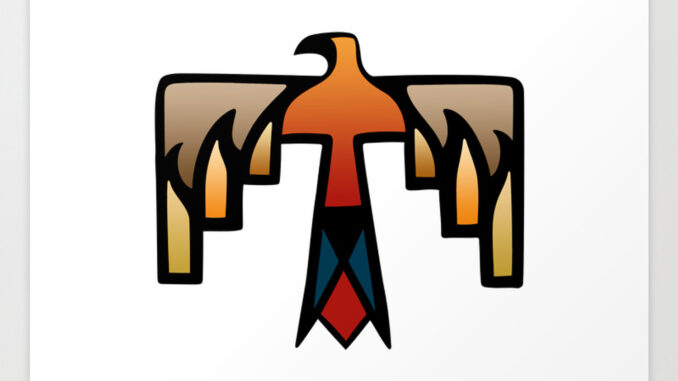
The thunderbird has been one of the most dominant icons in Native American art and legends. In fact, the concept of the thunderbird has been so popular that it has been used in the non-Native world to name a classic automobile, liquor, a 1960’s children’s adventure television show (and subsequent recent movie), a US Air Force squadron and is referenced in pop music (remember the word ‘t-bird’ in 1950’s rock and roll?). The thunderbird is one of the few cross-cultural characters in Native American mythology since it is found in legends of Pacific Northwest, Plains, and Northeastern tribes.
The Native Indians of the Pacific Northwest Coast always lived along the shores and never ventured inland to the mountains. Legend has it that the thunderbird, a mighty God in the form of a giant, supernatural bird lives in the mountains. The Quileute tribe of Washington state considered a cave on Mount Olympus as the home of the thunderbird while the Coast Salish believed it is located on the Black Tusk peak in British Columbia. It is thought that the thunderbird never wants anyone to come near its home. If Native hunters get too close, the thunderbird will smell them and make a thunder sound by flapping its wings. It would also roll ice out of its cave and down the mountain with chunks breaking up into many smaller pieces.
Some tribes such as the Kwakwaka’wakw believe that their people once made a deal with the thunderbird for its help during a food crisis and in return, the tribe agreed to honor the thunderbird for all time by making its image prominent in their Northwest Native American art. This is why West Coast art totem poles are often carved with thunderbirds with outstretched wings at the top.
The wingspan of the thunderbird was described to be twice as long as a Native Indian war canoe. Underneath its wings are lightning snakes which the thunderbird uses as weapons. Lightning is created when the thunderbird throws these lighting snakes or when he blinks his eyes that glow like fire. Sometimes these lightning snakes are depicted in Native American art as having wolf or dog-like heads with serpent tongues. They are occasionally referred to as the thunderbird’s dogs. Native American art portrays the thunderbird with a huge curving beak and prominent ears or horns.
The thunderbird is large and strong enough to hunt its favorite food which is the killer whale. The lightning snakes of the thunderbird are used during hunts out at sea for the killer whale. After capture, the thunderbird carries the killer whale back to the mountain to eat. According to legend, the thunderbird and killer whale once battled so hard that entire trees were uprooted. This was the explanation why there are treeless prairie regions near the Pacific Northwest Coast mountains. The thunderbird and killer whale are often depicted together in Northwest Native American art. A large example is at one by renowned Northwest Native American art carver Richard Hunt at one of the Northwest Native American art exhibits at the Vancouver International Airport.
The Squamish Nation in British Columbia, Canada has a thunderbird as their symbol. Their thunderbird is portrayed as one of the special messengers of the Creator. The Squamish thunderbird is a symbol for strength as well as change with the three tail feathers representing the past, present and future. In the talons of this thunderbird is a face of a lizard which represents spiritual protection for the people of the Squamish Nation.
For many people, Natives and non-Natives alike, the thunderbird has become a symbol of power, strength and nobility. Even the classic automobile of the same name was reintroduced as a contemporary version.
Unless otherwise stated, PONIREVO and/or its licensors DO NOT own any intellectual property rights in the website and material on the website. Majority of the site’s content has been scraped and auto posted by a third party artificial intelligence program —– PONIREVO Creation Team.
Proudly WWW.PONIREVO.COM
by Clint Leung



